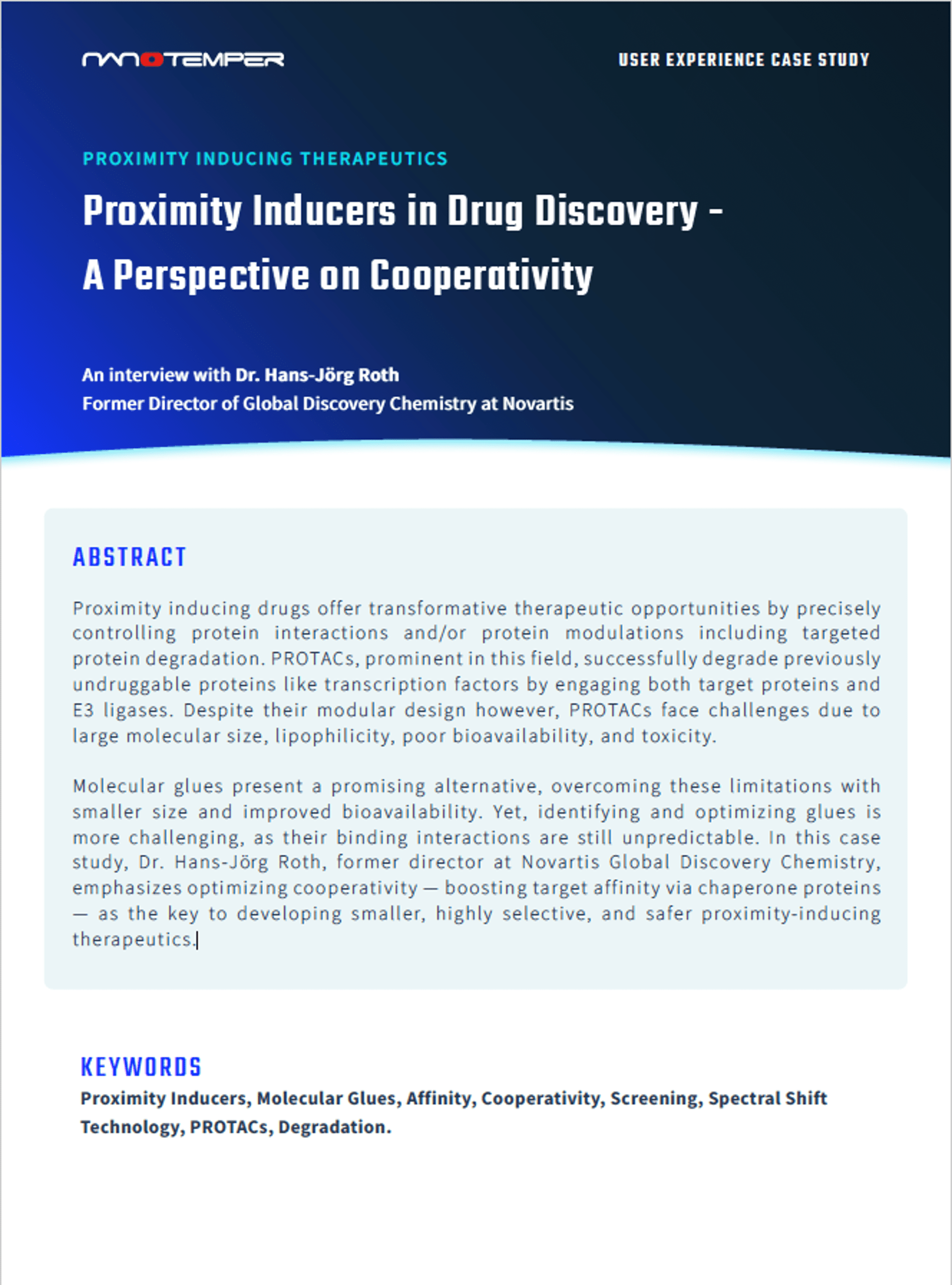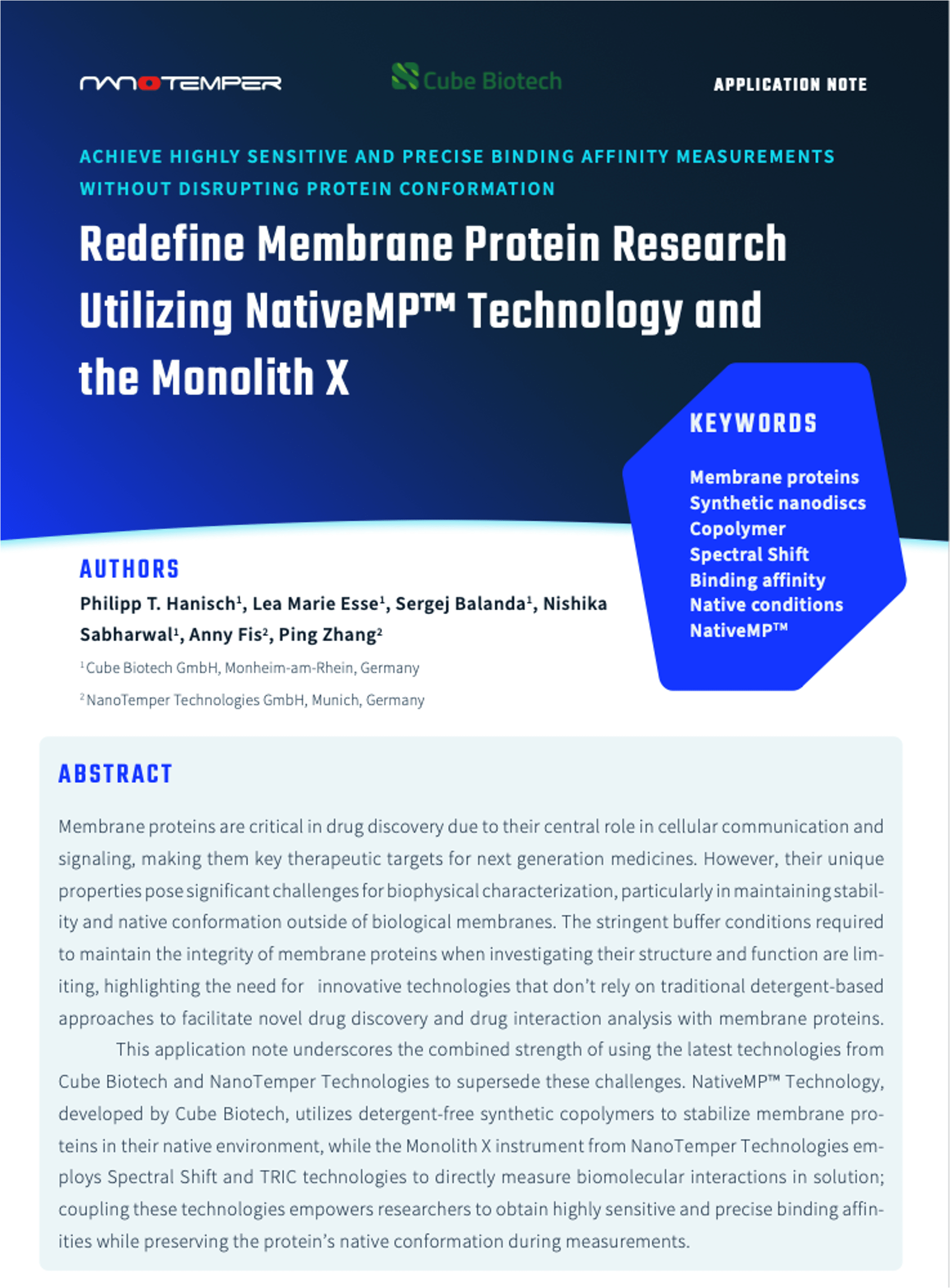Latest content
-
 Read
ReadUltra-high-throughput biophysical screening of MEK1 using the Dianthus uHTS platform
-
 Read
ReadGuide: Prometheus Panta Parameters Explained
This guide provides an overview of the key analytical parameters obtained with Prometheus Panta, their definitions and practical relevance for protein characterization and drug development.
-
 42:49Watch
42:49WatchQuality control during membrane protein purification for cryo-EM
In this webinar Dr. Melanie McDowell, Research Group Leader at the MPI of Biophysics outlines bottlenecks associated with membrane protein purification for cryo EM and strategies to overcome them
-
 Read
ReadPractical Guide: Quality Control Strategies for Membrane Proteins
When working with membrane proteins, whether you’re troubleshooting aggregation, testing new solubilization strategies, or deciding when to switch detergents read this guide for practical solutions.
-
 Read
ReadPowering Precision: How Automated Analytical Devices are Driving Smarter Biomanufacturing
Learn about Prometheus Panta C: A next-generation stability characterization platform that's helping biomanufacturers bring automation into the analytical core of their development and process control
-
 Read
ReadUnfolding insights: How nanoDSF is reshaping biotherapeutics development at Johnson & Johnson Innovative Medicine
Dr. Marius Müller of Johnson & Johnson Innovative Medicine shares insights from questions about the use of nanoDSF™ technology for ID-testing and at several late stages of biotherapeutics development.
-
 53:00Watch
53:00WatchCube x NanoTemper Webinar Series – Episode 2: Optimization of Membrane Proteins for Cryo-EM with Prometheus Panta
Explore a comprehensive, data-driven workflow—rooted in real-world results—combining the NativeMP platform with Prometheus Panta.
-
 Read
ReadNanoTemper Announces Prometheus Panta C: Powering Biopharma Breakthroughs from Preclinical to Commercial Manufacturing
NanoTemper Technologies announces the launch of Prometheus Panta C, a solution designed to meet the evolving needs of biopharmaceutical development—from preclinical phase to commercial manufacturing.
-
 Read
ReadBoost Your Lab's Performance: 3 Ways to Increase Efficiency with Prometheus Panta
Learn how to enhance your lab's efficiency with Prometheus Panta, from using capillary chips for high-throughput sample loading to solutions for seamless integration in automated workflows
- Contact Specialist
-
 Read
Read3 trends shaping the future of Biomanufacturing
Expert Marius Müller, PhD, Team Lead at Johnson & Johnson Innovative Medicine, shares insights into three significant trends that have potential to reshape the biopharma and biomanufacturing industry
-
 Read
ReadProximity Inducers in Drug Discovery - A Perspective on Cooperativity
-
 1:45Watch
1:45WatchPrometheus Panta for your automated workflows
Increase your throughput, improve precision, and streamline your workflow by automating biologics characterization. Discover Prometheus Panta, an instrument for multi-parameter stability measurements
-
 31:28Watch
31:28WatchnanoDSF as an efficient, high-throughput method for ID testing in biologics manufacturing
Watch this webinar to discover how Dr. Marius Müller from Johnson & Johnson Innovative Medicine, uses nanoDSF, a high-throughput method that assesses protein stability, for drug substance ID testing.
-
 Read
Read5 biologics conferences you won’t want to miss in 2025
Use this curated list of must-attend 2025 biologics conferences to plan your year. Find out when and where each conference takes place, who will be there, and what you can expect.
-
 43:09Watch
43:09WatchCube x NanoTemper Webinar Series – Episode 1: Optimize membrane protein characterization with NativeMP and Multiplexing Optical Methods
Learn about technologies and instruments that maintain membrane protein stability and allow structural abd affinity screening studies in their natural lipid environment.
-
 Read
ReadAchieve Highly Sensitive and Precise Binding Affinity Measurements Without Disrupting Protein Conformation
-
 Read
ReadPushing Boundaries in Biophysics and Biomanufacturing
Marius, a biophysics expert at Johnson & Johnson Innovative Medicine, shares his insights into this rapidly evolving field of biomanufacturing.
-
 Read
ReadBinding Affinity Explained - Your guide to understand, evaluate, and purchase the best solution for your lab.
Whether you’re just starting to learn about binding interactions or you want a refresher, this guide provides helpful tips to better understand, evaluate, and eventually purchase the best technology
-
 21:30Watch
21:30WatchFluorescence-Based Technologies for Binding Affinity Studies: Benefits and Labeling Best Practices
Regardless of fluorescence technology (i.e Spectral Shift, TRIC, or FRET), optimizing your labeling strategy is essential to minimize impact on the functionality and ensure accurate Kd measurements
-
 26:58Watch
26:58WatchHow Immunocore tackles formulation development and delivery challenges for novel bispecifics
Watch this webinar about approaches and insights into bispecific formulation development and screening with Prometheus Panta for thermal and colloidal stability characterization of biotherapeutics.
-
Loading more...



